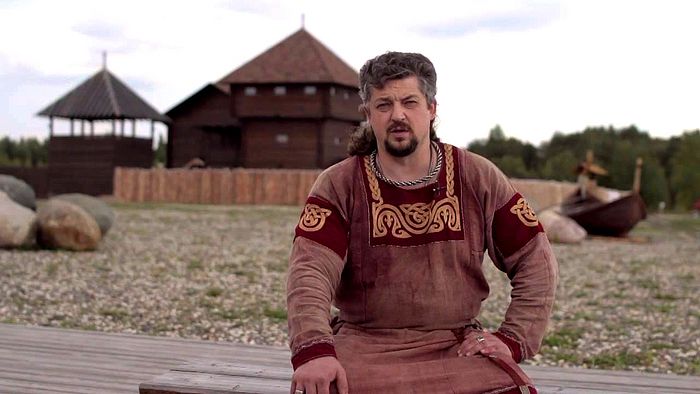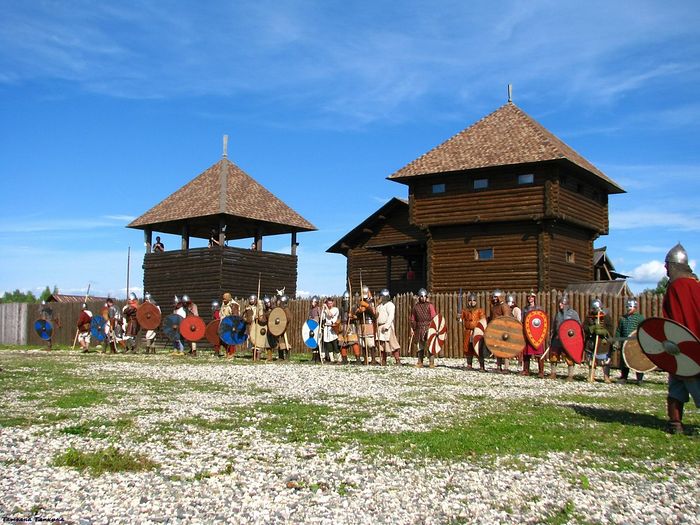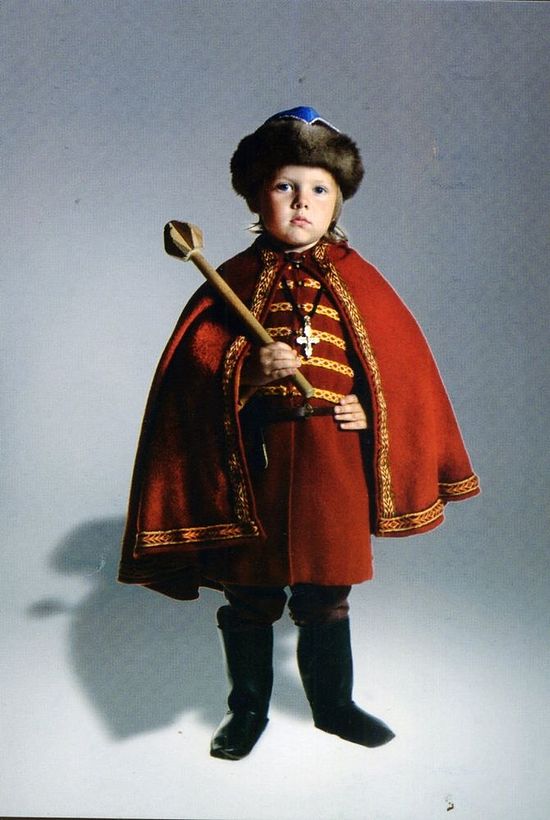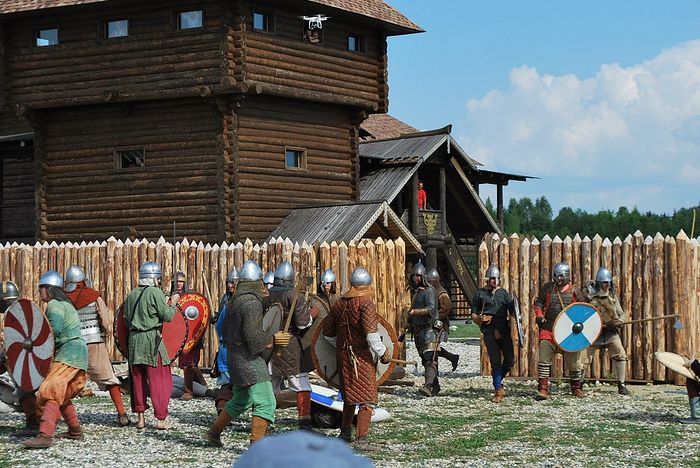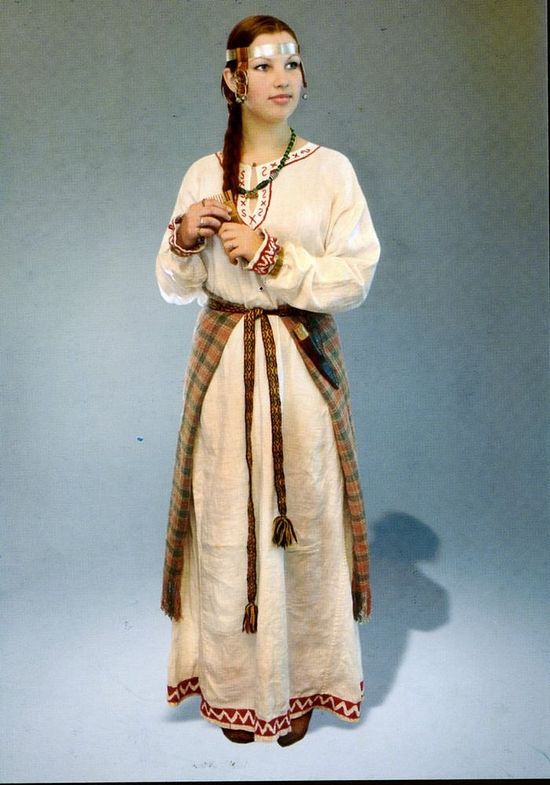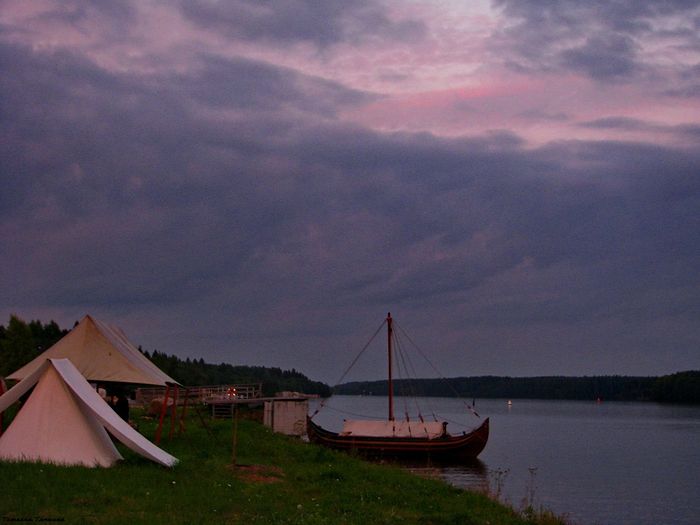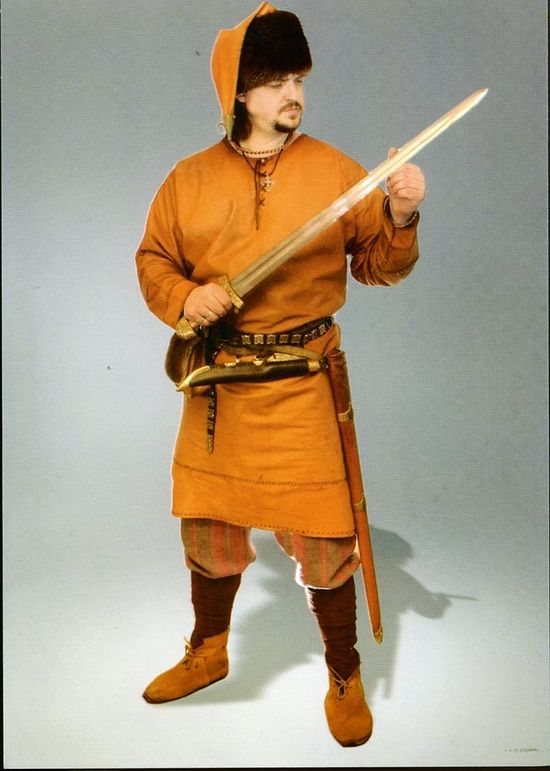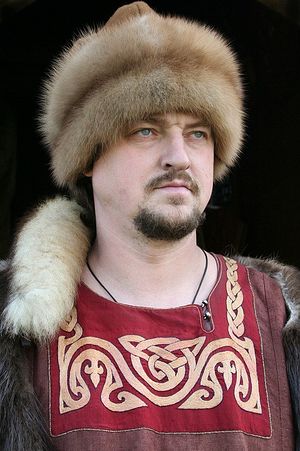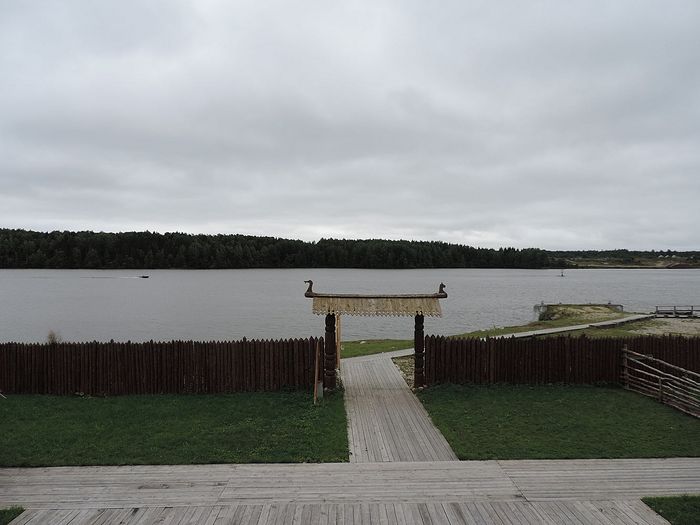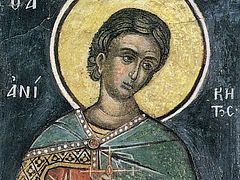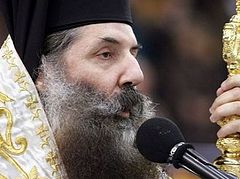You will feel like you have returned to the Middle Ages in the vicinity of the ancient town of Belozersk in Russia’s Vologda region, on the banks of the river Sheksna, some fifteen kilometers from the Monastery of St. Cyril of Beloozero (White Lake). It is here that the “Sugorye” historical and ethnographical complex is located where an old Russian prince’s country estate has been reconstructed complete with a sturdy watch tower, a gridnitsa [in old Russian architecture a large hall for the junior retainers (gridi) of a prince at his court. It was also used on festive occasions] and a peaceful Viking house beside it. There are also a smithy, an armory and even a subway. The main visitors to the estate are children who mostly come from other regions, which is good because historical re-enactment encourages people to study history, says Igor Alexandrovich Ruchin, the director of “Sugorye,” a historian and re-enactor. And those from Orthodox countries who know their native history will never feel like a tourist at an Orthodox church. We spoke with him after a school excursion during which the children nearly destroyed the gridnitsa, excited about the opportunity to play the part of epic heroes, princes, princesses and to have sword fights. The “princes” and “princesses” reluctantly went to have dinner after the tour, while a breathless Ruchin collapsed onto a bench in relief.
—Igor, let us start by destroying stereotypes. After all, many are prejudiced against historical re-enactments. They say adult men and women play knights, guided by their own fantasies of “how it really was”—in other words, by tales or movies they watched in their childhood. And moreover, movies are the most “historical” sources in comparison with what is in the minds of those who have lapsed back into childhood. More than that, many believe that historical re-enactment is under the strong destructive influence of neo-paganism (“the Slavic native faith”), becoming an arena for this movement’s “ventriloquism.” Is that true?
—Let’s consider all this in order. As for whether historical re-enactment has a right to be called “historical” or not: yes, I have had to deal with the opinion that these are allegedly just “games for adult men and women” my whole life. But recently there has been considerably less criticism: people obviously see the results of our activity, draw the right conclusion and begin to respect us. Earlier we had to face a total lack of understanding. I was nicknamed “the first knight in the village,” “a hello from the past,” and so forth. Yes, it may seem very odd for residents of a small town to see a father of six children (“instead of busying himself with normal men’s work: kitchen-garden, fishing, hunting, and vodka”) building fortresses, making chain mail, spears, shields and other things and, in addition to this, calling to study our native history on the basis of all this. Even when we proved the use of our initiative by building a gridnitsa, a Viking house, a forge and a boat, by organizing a historical festival, by attracting numerous tourists (which was a great financial help for our town), I kept hearing the following remarks: “He should unload railcars instead of wasting time with this history! That would be more helpful! We do not care about this history!”
Of course, it is very sad if I am more helpful to my country and fellow-citizens by unloading railcars than by “reviving” our history. In my view, every single person has his own talents and it is logical that each of us should work in the sphere where he is an expert: somebody will help his country as a loader, while someone else will help the nation by introducing folks to the history and giving the masses access to this history. But, nevertheless, they finally recognized our right to do what we can do well.
Concerning the need for studying national history, I am firmly convinced that it is not a rhetorical question but rather an urgent need for our nation. “But in order to stand, I have to hold on by the roots”—this song is still quite relevant.[1] A tree without roots, a country without history is doomed to die, and it will perish in a shameful way as it has nothing to hold onto. Today we can see it in our southern neighbor—poor Ukraine: the perversion of its national history, the renunciation of its own roots… Attempts to adopt some alien elements at any cost always lead to the destruction of a state and a society—and this is just what we have been observing in Ukraine with an aching heart.
It is clear that we must study history and bring it to the public’s attention with all our strength. But how should we popularize it? It is time to talk about the use of historical re-enactments. Studying history in a class-room or a lecture room, cramming dates and making diagrams, is one thing. I very often meet people who say that they hate history after being taught it as a subject at school. Both in the Soviet and the post-Soviet periods history as a subject has been like a selection of facts, numbers, dates, names, and recently a great number of various diagrams and charts have appeared. So history as a science about the life of people, like you or me, who lived before us has been reduced to cramming with diagrams and vectors… How can it attract the interest of a teenager who spends all his time in a classroom? I have no idea. Such history certainly does not hold attention. In my judgment, this “arid” teaching of history kills the living link between generations.
Yes, nobody is arguing that diagrams and charts are wholly irrelevant because we must know, for example, how the Russian industry developed at a certain period. But we cannot reduce history to diagrams. Likewise, we cannot reduce Crime and Punishment and Eugene Onegin to a mere morphological analysis—that would be nonsense, not literature! It’s the same with history: we need to realize that it is a living science which enables us to feel our link to the holy princes Vladimir the Great, Alexander Nevsky, Dmitry Donskoy, and other figures.
I personally had excellent teachers. One of them is currently the director of the Museum of Archeology in Cherepovets in the Vologda region, the famous archeologist Alexander Valentinovich Kudryashov. He taught in classes too; and his lessons were always so interesting and vivid that his students did not want to leave! He cultivated a deep love for archeology in us: he would take our classes on excavations and then opened a wonderful school museum on the basis of archeological finds, and we worked as guides in it. When you are fifteen years old and you have some basic knowledge of history and archeology that’s significant. Yes, we did have and experience all of this: excavations, work with shovels and brushes, gnats and gadflies, songs by fire, pot meals, and the most captivating educational talks on people who had lived here a thousand years before us. After that any person cannot help but respect and maybe even love history.
What do I mean? Teaching and the popularization of history must be many-sided, and historical re-enactment is just one of these sides, and one of the brightest which is designed to awaken people’s interest in history and to encourage them to study it. We have been re-enacting earlier original life not “at random,” “unthinkingly,” but using scientific data, historical patterns, and surviving artifacts or a whole complex of historical sources.
Costumes are not just precious fur
—What sources do you mean?
—First of all, archeological sources. These are artifacts found in the cultural layer of a certain period—judging by these finds we can ascertain what a twelfth-century arrow head or a thirteenth-century arrow head was like and find out why they changed. Or let us take belts which were clear indicators of soldiers’ statuses—why did certain innovations appear at a certain stage? and so on.
There are also written sources: travelers’ diaries and notes, their descriptions of the way of life, patterns of behavior, faith and even clothing of the inhabitants of one or another district. The sources also include information from all kinds of chronicles and cadasters. Apart from this, there is one more source: depictions. These include images and depictions in chronicles, and Church paintings and icons of the age. We should take into account that the primary task of icons is not to familiarize us with details of people’s everyday life, but to acquaint us with the people’s faith and to give us an idea in what they believed. But, for instance, the icon called “Praying Novgorodians” gives us some information about the outfits of Veliky Novgorod residents in the fifteenth century.
—Does a description of clothing really matter? I share an interest in people’s faith and mode of life, but is it important for me to know what our ancestors used to wear in the eleventh or twelfth century? Maybe women will be interested in this—patterns, pendants…
—I’m afraid you are wrong here. If you seriously study such things as national outfits (study, but not “dream up” some idea), then you come to understand that this detail is not of minor importance at all. Let us take adornments. Do you know why Slavic elements appear on the national dress of the Russian north which was then inhabited by Finnish peoples? The fact of the colonization of the north by the Slavs is evident, but was it a peaceful colonization? If the relations between the Slavs and the Finns had been bad, then the local national costume would have never combined elements of both peoples’ adornments. But if their relations were good, then this development of dress is very logical. Therefore, even clothing can show us how things developed. To our northern region’s credit, the relations were very friendly.
—Then please tell us about clothing in more detail.
—As opposed to modern dress, ancient folk costumes were very informative and multifunctional, like a business card. Such things as a kin, a tribe, a religion, a profession, and social status were expressed in a costume’s design by means of numerous attributes, signs and symbols. An outfit’s material, style, range of colors, presence or absence of certain elements, ornamentation and decorations all come together to create a full image of its owner. In this sense, studying old Russian costumes enables us to have a better picture of the everyday life of the population of old Russia along with its worldview. The eastern Finnish national dress which was traditional for the Belo Ozero district was given a huge impetus by the Slavic settlers who enriched it with elements characteristic of their culture. The district’s trade links with the Volga river basin and the Baltic contributed to the appearance of new forms of clothing as well as types of adornments, which had an important religious meaning in ancient times, in Belo Ozero. The blending of cultures is most noticeable in formal women’s attire which included a large number of metal adornments, worn in a strict order. The decoration of old Belo Ozero costumes can be regarded as the best achievement of applied art of tenth-eleventh century north Russia. During this period the set of adornments changes, new forms appear and disappear, and attire itself becomes simpler, losing its barbarian grandeur, and pagan elements are supplanted by strong Christian ceremonialism in the dress. The one Russian nation came up to take the place of the Slavic and Ves’ tribes, and blood of various tribes who found their home in the area of Belo Ozero flows in its representatives’ veins.
Thorough research, both archeological and ethnographical, enabled us to win in historical festivals. I will repeat myself: we are guided by research, not fantasies. Why did we decide that the costume of an ancient Belo Ozero inhabitant was a complex of linen cloths supplemented with fur cloaks? Because an Arab traveler named Abu Hamid Al-Garnati mentioned this in the twelfth century! He visited Volga Bulgaria[2] and met with representatives of the Ves’ tribe. By the way, the towns of Cherepovets and Vesyegonsk derived their names from Ves’. Thus, he described Ves’ as “people who wore linen clothing which protected them from the cold along with clothes of fine beaver skins” This serves as an excellent source for historical re-enactments.
There are plenty of sources, but they are mostly individual and separate. The goal of a re-enactor is to gather them all and to prepare a logical, consistent and reasonable system which will be appropriate for a given epoch. And you will need to verify the “correctness” of your system, relying on your knowledge and research, putting forward hypotheses and being prepared for criticism. And now this is what can be called a genuine scientific effort, which presupposes serious research, and not inventions or fabrications.
What's good to a hobbit is of concern for a psychiatrist
—So it has nothing to do with so-called role-playing games?
—Definitely. Playing elves, hobbits, orcs and other mythical creatures is one thing, but historical re-enactment is another thing. I hold that these games are dangerous for one’s spiritual and mental health. I more than once met people who played past heroes or characters from fantasy literary who got so caught up in their roles that they ended up losing their own identity. Roughly speaking, they became schizophrenics. That is why we feel confident that work, hobbies and everyday life should be separated. Indeed, at work we wear re-enactment medieval costumes to familiarize our visitors with them, but by no means do we wear the same at home. In our everyday life we drive our cars and not ride on horseback, we cook food in multi-cookers—not over the open fire. Likewise, we do use telephones and computers, but we hang neither bearskins and wolf skins nor spears and shields at home.
Christianity as a requirement for preserving peace
—Igor, you have devoted many years of your life to historical re-enactment, study, archeology and ethnography. Can you briefly share the main conclusions of your research with us?
—Even briefly it would take a considerable amount of time. But I will raise the issue of patriotism. I am ashamed when under-educated people constantly make reference to the so-called “civilized world.” We are not in the Stone Age ourselves and are not running with axes across Russia! We have a great many writers, artists, poets, designers and other specialists of our own in every corner. If you find something good in other countries, feel free to adopt it; if there is something good in your own land (and there has always been a great deal of it in our land), then your duty is to preserve it and not to forget it. Had we been a wild tribe, we would have never created a state like Rus’ and would have never established a country like Russia. This is what history teaches us. And a sensible re-enactment, based on historical facts and research, contributes to it enormously.
—And are you making progress?
—I think we are. Many people, overcoming stereotypes based on self-humiliation, discover to their surprise that in olden times the Norse called Kievan Rus’ “Gardariki,” that is, “a land of cities.” When the Norse still lived in small isolated farmsteads, scattered amid northern fjords, we already had several dozen large, well-developed cities. After all, a city is a center of crafts and trade. Moreover, it is a real military fortification with ramparts, a moat, watch towers and so on. It is clear that the existence of such large centers is an indication of a highly-developed civilization. Spiritual and political power was concentrated in cities, as it was in Belo Ozero: it was used as a base from which Orthodoxy was spread throughout a huge territory. It was from there that the rays of the district’s Christian enlightenment ran. I think all of us should know it and thank our forebears for their labors. I will repeat myself: there are absolutely no signs of any armed conflicts among the neighboring tribes and peoples in Belo Ozero. And the preaching of Orthodoxy played an important role here: it was peaceful, friendly, open to other peoples and free from any arrogance. Unfortunately, the same cannot be said about our border districts where, according to chronicles, there were many armed clashes and even cases of terror. It is there that mass burials have been discovered—these appeared following nomads’ inroads into old large Russian cities. Indications of internecine wars between princes and struggles for power have been also found there—at that time the scorched earth policy was applied effectively against their own countrymen. But the area around Belo Ozero had not experienced this up to the fourteenth century when Moscow began struggling with Rostov and Novgorod for these lands. And here we already find the evidence of wars, campaigns of ushkuyniks,[3] retaliatory measures of feuding parties and so on. And, beyond doubt, the population suffered immensely from all this.
—And who were the ushkuyniks?
—They were “Novgorod Vikings” of a sort, the Slavic “gentlemen of fortune.” These were explorers, colonizers, merchants (but not in the traditional sense of this word), but mostly real robbers and pirates. They struck fear into inhabitants, as was the case with Vikings elsewhere.
How can neo-pagans surprise us?
—It is no secret that historical re-enactment is within the domain of so-called neo-pagans. Does it pose a threat to science?
—Yes, it poses a threat not only to history as a science, but also to people. It’s dangerous for science because neo-pagans do not rely on authentic sources. History is a science of sources, and if sources are disregarded in favor of your own beliefs and fantasies then it is not a science at all. There are not hypotheses either. Hypotheses always rest upon a whole array of reliable historical facts, but neo-pagans offer neither facts nor thought. They offer only fantasies and speculations which always involve Perun and Veles.[4] No research is done there on principle; the only thing they need is to justify their ignorance and hatred of Christianity.
—Even hatred! But why not confess your faith without hating others?
—It is very simple: neo-paganism cannot exist without hatred of Christianity. I am convinced of this every time I meet neo-pagans. There is a whole range of “tender feelings:” contempt, fear, hatred and even envy which is hidden behind the first three. If Christians can prove and demonstrate the fundamentals of their faith, relying on, among other things, different sciences: history, philosophy, religious studies and others, then pagans have fragmentary and scanty information which they cover with a layer of mystical fabrication. And this mysticism has its roots in quite dangerous pseudo-spiritual practices. This defective mythology is explained by the need to find at least some foundation, some justification for their convictions. There are some laughable occurrences. Once at Kulikovo Field[5] several guys in rags appeared during a festival and started to yell: “Glory to Perun!” And then they tried to convince everybody that Russian soldiers had allegedly behaved the same way during the battle against Mamai. We asked them: “Where did you get this information from?” And they answered proudly: “We just know it!”
—By the way, is a sane dialogue with neo-pagans possible?
—Judging by my personal experience, it’s very rarely possible. When you ask them about the sources of their beliefs it turns out that their chief sorcerer Dolboslav, after long shamanistic rituals, saw Perun in a dream and the latter revealed to him such-and-such a secret. This is what their theology is like! Whenever you attempt to enter into a serious conversation with them they quickly become very nervous, and your friendliness (and I do not want conflicts; I honestly want to know the origins of their historical and religious beliefs) is met with hysterical aggression towards Orthodoxy. The explanation is very simple: people who do not have inner discipline (which is necessary in Christianity) feel panic-stricken terror and an unwillingness to make a step forward towards Christ. But if they make this step, they will be faced with a choice: to give up their numerous self-destructive desires and inventions or to continue their wretched way of life. True, neo-pagans often savor Christians’ sins (both imaginary and real), point their fingers at them and say with an ironic grin: “Look at yourselves! You are not better than we are.” And I mention this to the shame of Christians. But any Christian who sins knows that sin is bad and he does not try to justify himself or his sin. And it is easier for pagans: what is considered a sin for Christians is regarded as a virtue for many of them. And it is harder for a Christian: he will suffer, he will be ashamed, he will be given to self-analysis and repentance. That is painful but worthy of respect.
It’s scary sometimes to look at what people do with their own interpretations of paganism. In my work I often have to communicate with people in social networks. Not long ago I saw that one person had changed his profile picture: a savage grin, a wild look, a distorted face, and wolf’s fangs on his neck. In his opinion, this is how any true Russian (“Rusich”) should look. That is, a Russian is automatically a pagan…
I was very shocked by that change: the guy is over forty, a former officer, a genuine Russian strongman with a bright face and a kind smile. But he left the army and ended up in a pseudo-pagan sect which has nothing to do with real history. As Dostoevsky rightly said: Russians know no middle way. If they take some idea, then they follow it wholeheartedly… It is terrible to watch!
—So, historical re-enactment can entail both common sense and its perversion?
—Yes, that’s how it is. And it concerns not only re-enactment, but also literature—to everything! It is so disappointing that our society chooses fools and clowns as its teachers, if not prophets. Do they do it for laugh and entertainment? No. Ideas put forward by these clowns are considered as true “revelations” in linguistics, history and religion. Once one such “prophet” intended to come to us in order to shoot another “historic masterpiece” and prove that Christianity was allegedly alien to Russia and that our ancestors allegedly worshipped Ra.[6] Honestly, we weren’t delighted with this news, but God preserved us from this visit. The “guru” of history fell ill and in the end didn’t come. May God grant him physical, intellectual and spiritual health.
—Are there any examples of people who, whether through ignorance or because of their young age, were caught up in some kind of romanticized, a-historical “re-enactment,” but then found there way out of it, and consequently, of neo-paganism?
—Yes, thankfully. Much depends on the sincerity of those seeking a way-out. If a person seeks for the meaning of science or faith seriously, then he will surely find it, sooner or later. There are a few guys who work with us who started familiarizing themselves with science, with real re-enactment, and have finally appreciated its use for both mind and soul. If a person is intelligent, interested and is able to analyze, then he will never give in to any foolish tricks towards Orthodoxy—the faith of his nation.
Even those who declare they are pagans sometimes can surprise and please us. The Christianity of their ancestors has not died out in them completely. Once we were talking on the theme: “Paganism as the true faith of the Russian people.” I asked the participants to be frank with themselves and told them: “If you, guys, are genuine pagans, as you declare, then, based on numerous results of ethnographical research, I demand that you do the following things in support of the sincerity of your beliefs,” and then I quoted them extracts from ethnographical studies of the eighteenth–early twentieth centuries which contain such vestiges of paganism of everyday life of the age that anyone would immediately feel strong disgust! In short, it was extreme abominations. To these guys’ credit let be it said: they started spitting and asked with indignation whether I had gone mad. “No, I am not crazy. I am just telling you about your faith, using scientific facts. Will you do these things? And do you sincerely believe that the sun is Hors[7] and not an accumulation of some extremely hot substance? Do you really worship Perun? If you do, then sacrifice a couple of infants to him, as your ‘glorious forebears’ did! This is what the soldiers of Svyatoslav did during the siege of Dorostolon![8] After all, that is normal.” “Away with you! No way!” they exclaimed in reply. Their reply comforts me and gives hope that we have not abandoned Christ completely and still have a chance to return to Him. For those who call themselves pagans in reality reject the spirit of paganism in their heart of hearts. But any flirtation with paganism is very dangerous as it is.
On the transformation of mind and memory
—But to deny the existence of paganism in Russia would be incorrect.
—Nobody denies this! I recall our conversation with Archbishop Maximilian (Lazarenko) who once visited us. I felt shy when I was telling him about the influence of paganism on the customs of Russian people and showing him pagan symbols in old Russian costumes and home decorations. The archbishop said, “That is right. All of this did take place. But let us reflect on the fact that Christianity transformed Russia’s pagan infancy, replacing worship of the creation with worship of the one Creator of all things… Tell your visitors why and how Russian people chose to worship Christ, the Sun of Truth, instead of naïvely worshipping the natural forces. Tell them about the difference between the terms ‘slave’ and ‘servant of God.’ And let us remember the significance of Christian Transfiguration. Make human minds work, and then, I hope, their souls will start working too.”
—Some accused and still accuse St. Alexander Nevsky of “servile submission” to the invaders. They argue he submitted to the pagan Tartars, while St. Dimitry Donskoy, with the blessing of Venerable Sergius of Radonezh initiated the liberation of Russia and defeated the Tartars. What is the difference? Why did the former submit, while the latter began a liberation war?
—We should remember that in the thirteenth century Russia also had much worse enemies—its potential conquerors—than the Mongols who then were tolerant towards Orthodoxy. While Mongols were interested only in the material aspect of occupation, the neighbors from the West thirsted for Russia’s spiritual occupation. By the way, the results of that longing can clearly be seen in today’s Ukraine. This Uniate “Church,” these divisions and schisms, are fruits of that early history, when prince Daniel of Galicia (Danilo Romanovich) requested aid from the heterodox. But he neither received assistance nor saved Russia from pillage. Meanwhile, St. Alexander Nevsky, removing the menace of spiritual occupation from the West, submitted to the Mongols and thus saved hundreds of thousands of human lives and preserved Orthodoxy. As the historian George Vernadsky put it: “These were the two heroic deeds of St. Alexander Nevsky: the exploit of struggle in the West and the exploit of humility in the East.” By the way, thanks to him many invaders subsequently became Christians by divine providence.
However, by the fourteenth century the Horde was no longer tolerant towards the faith of Christ, and indeed Mamai can be characterized as a Muslim extremist. And at that time there could be no more compromises… We are well aware what happened eight years later on the Kosovo Field in Serbia. Serbia, defeated by the Mohammedans, was under their sway which was very destructive for Christianity. Thus, our prince had to take the sword and begin the liberation of Russia which started at Kulikovo Field:
“Our war leaders have already been appointed—seventy nobles and the valiant princes of Belo Ozero, Fyodor Semyonovich and Semyon Mikhailovich, with Mikula Vasilievich, both Olgerdovich brothers, Dmitry of Volyn, Timofey Voluevich, Andrei Serkizovich, Mikhail Ivanovich and thirty thousand armed men with us. Our leaders are trusty, our companions are experienced, our steeds are spirited beneath us, our armor is gilded, our helmets are Circassian, our shields are Muscovite, our javelins are German, our daggers are Frankish, our swords are of steel; our roads are known, our fords are prepared and all are eager to lay down our lives for the Russian land and the Christian Faith. Already those falcons, birds of prey and hawks of Belo Ozero have flown swiftly across the Don and swooped upon the countless flocks of geese and swan. But they were not falcons and birds of prey—but the princes of Rus’ (Russia) who fell upon the Tartar hordes. Forged spears clashed, gilded armor rang out, reddened shields knocked together, steel swords crashed on the helmets of the foe on the Field of Kulikovo by the River Nepryadva. It is not the aurochs that roar by the great Don on the Field of Kulikovo. It is not the aurochs that lie beaten by the great Don, it is the princes of Rus’ (Russia), the nobles and war leaders of the Grand Prince Dmitri Ivanovich who have been cut down. It is the princes of Belo Ozero, Fyodor Semyonovich and Semyon Mikhailovich, Timofey Voluevich and Mikula Vasilievich, Andrei Serkizovich and Mikhail Ivanovich and many others of their company who lie struck down by the Tartars” (from the Zadonshchina manuscript).
As a resident of the Belozersk district, I am proud and pleased that our ancestors from Belo Ozero took part in that great battle, though these are feelings of mixed sorrow and joy, because all of them were slain. Nevertheless, I want as many people as possible to share the same feelings towards our forefathers: deference, pride, joy and sorrow for them. And they need to do it with all their hearts, knowing the glorious deeds of their forebears, not feeling like strangers on their native land and like tourists in Orthodox churches. This is the main purpose of our work.

